Surviving a Month with Two Weeks’ Water
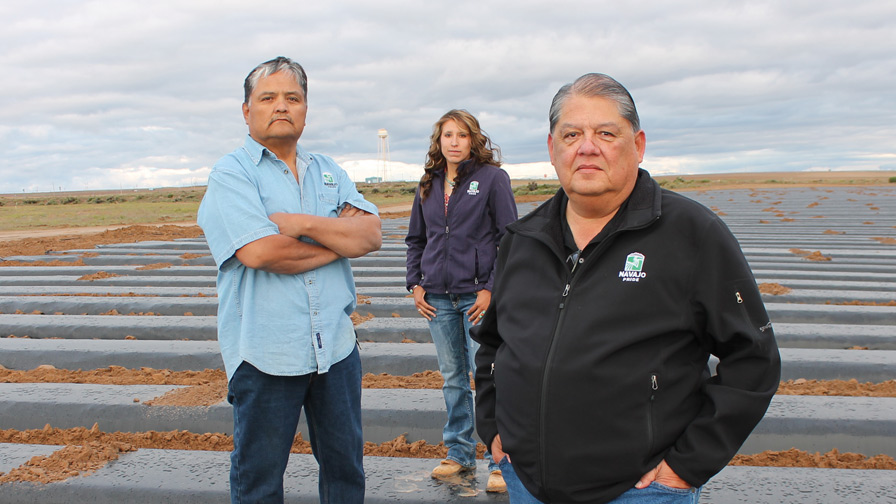
Aaron Benally, Amanda Kerr, and Michael Castro are leading the charge in making Navajo Agricultural Products Industry’s production more diverse, making it strong enough to endure any future challenges. All photos by Rae DeGroat.
Imagine yourself in this nightmare scenario: At the height of the season, the pipeline that carries water from your only water source bursts. Repairs will be costly. And, even when executed as quickly as possible, it will be a month before you have access to new water. That means you have to make do with the water you have on hand — not more than a two weeks’ supply.
What would you do?
Hopefully, you would mimic what the team at Navajo Agricultural Products Industry (NAPI), a 75,000-acre grower near Farmington, NM, did when they faced down this catastrophe in May 2016. Not only were they able to tack together an emergency plan that helped them make it through the season, they pivoted off this disaster to aggressively reinvent the farm so that it could survive if something this damaging happened again.
How the Crisis Unfolded
One day in May of last year, the water pressure in the enormous 17-foot diameter siphon pipe that connects NAPI’s water source to its farm 40 miles away suddenly dropped. Remote canal elevation gauges stationed along the pipeline quickly identified the problem: the pipe had ruptured.
Emergency gates immediately dropped to preserve the water already on its way to the farm in front of the rupture, and to stop water flow from the reservoir.
The pipeline dates to the 1970s, as a result of legislation signed by President Kennedy to give Eastern New Mexico and Western Texas access to water from the Colorado River Basin. As part of that legislation, a new water district for the Navajo Nation was created.

Cutter Dam Reservoir, 40 miles from the farm, is NAPI’s source of water. A 17-foot diameter siphon pipe burst 7 miles shy of the farm, cutting of water for a month.
Water travels to NAPI from a reservoir 40 miles away via a series of dams, tunnels, and siphon pipes. The huge siphon pipe is reinforced with steel bands, which keeps its structural integrity intact.
And that turned out to be the source of the problem. Several bands surrounding the breach area failed.
In a populated area, having a 17-foot-diameter pipe burst would have been devastating. Luckily, most of the pipe runs along a canyon floor, including where the break occurred. So the wall of water barreled down the canyon and spilled into the desert wash, dissipating without harming anyone.
When an assessment of the damage was made, the verdict was grim. That pipe section needed to be replaced. But when you’re dealing with a pipe that large, it must be custom-built on site.
Technically, the government is responsible for the repairs. But the amount of bureaucracy involved in getting the repair done would have slowed things down to an unacceptable level.
So one of the first decisions NAPI’s leadership had to make was to pay for the repair itself and pursue reimbursement later.
That done, NAPI faced a grim reality. It would take a month before the water could be turned back on. And they had about a two-week’s supply in their irrigation canals.
“We had to ration what we had,” says Michael Castro, NAPI’s Chief Operating Officer.
A lot of big decisions faced them.
“When that water stopped, it hit home. It really brought people together, and it sent the message that as a company, we all need to be united and we all need to work together,” says NAPI Chief Executive Officer Wilton Charley. He had taken on the role of CEO only two months earlier when this happened, although he had worked with NAPI in the past.
Many crops were well underway, while others were due for planting.
So the NAPI emergency team prioritized the crops by value and how vulnerable each was. The farm at the time had five main crops, including both commodity and specialty crops. Due to their stronger margins and water needs, specialty crops rose to the top of the priority list.
“We had everything from alfalfa to potatoes growing out here, all at a critical stage in the middle of the season,” Castro says.
NAPI decided against planting the 20,000 acres that were due for planting.
As for those crops already planted on the remaining 35,000 acres, they had to prioritize. Here’s how the crops were ranked:
1. Potatoes
2. Pinto beans
3. Wheat
4. Alfalfa
5. Corn
There was so little water, even crops at the top of the list could not receive normal amounts of water. The team was about to embark into unknown territory, seeing how much they could salvage with less than optimal irrigation levels.
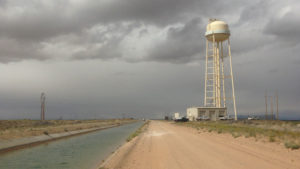
NAPI tested how quickly the irrigation canals would drain under normal use so crop managers would have a better idea of how severely they needed to ration.
How the Crops Fared
Outside of carefully controlled research fields, there aren’t a lot of opportunities to learn how crops react to extremely low irrigation.
Although NAPI has highly skilled growers, they quickly learned the usual tools that guide decisions were all but useless.
One example is leaf analysis. NAPI ordered the tests fairly early on, but the crops were already experiencing stress, skewing the results.
So the team made the best decisions it could based on its considerable experience.
“We were flying in the dark,” Castro says.
POTATOES. All of the potato crop had been planted at the time of the breach, Castro says.
Of that crop, exactly half had emerged, and half had yet to emerge, says Amanda Kerr, Crop Manager.
Existing practices of building a bank of soil moisture in the soil helped NAPI limp through the emergency, as did relying on in-house experts, and outside consultants and researchers’ knowledge of historical crop data from previous droughts. But the crop was still hit hard.
The plants that had emerged at the time the pipe rupture were hit hardest.
“They shut down, stopped growing; then the heat came in. It basically baked them,” Kerr says.
When the water supply turned off, all areas of production were affected — from crop protection to fertilization.
When the water came back on, the team nursed the crop back to life. Its efforts paid off with a close to normal yield. But all its care couldn’t undo the damage.
Of the potatoes that had emerged, 80% were graded No. 2 in quality. Those that hadn’t emerged performed a little better, with only 40% getting a No. 2 grade.
“Normally 90% of our entire crop are No. 1,” says Aaron Benally, Crop Director.
PINTO BEANS. The second crop NAPI grew in 2016 was pintos.
This crop normally would have fared well without the usual level of irrigation water, Castro says. But for one thing: weeds.
Weeds were just getting started when the pipe burst. Since NAPI waters in its herbicide, it wasn’t able to apply it when it was needed.
The result?
“You get a field of weeds and beans,” Castro says.
That meant a lot of weeds in the silo, which discolored the pintos.
“We suffered a pretty good loss on the beans because of the lack of water to set in the herbicide,” he says.
CROPS NOT PLANTED. The fields NAPI decided against planting were continuations of crops already underway. It didn’t finish acreage on wheat or pintos, Castro says, and they cut back on corn, and cut a lot of water to alfalfa. Potatoes, however, were all in.
All these losses added up to an expected $4.3 million.
“Fortunately, the company was in a position to absorb it,” Castro says. “Financially, it had good oversight through the years. If we had done things any differently, it could have been the end of the company. Easily.”
Eight Changes NAPI Made so It Could Survive Another Disaster
What NAPI experienced is dramatic, but this isn’t the most significant part of its story. How it changed its practiced as a result, is.
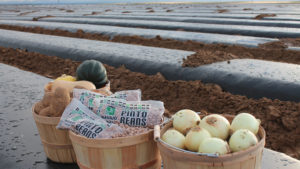
NAPI is adding several new crops to the existing five it grows in 2017 and 2018
Prior to the breach, NAPI had been weighing how it wanted to change in the future. Charley says Castro was brought on board with some of those changes in mind.
The leadership’s ideas for change were to gradually, carefully test concepts and inch its way to a more diverse crop profile and see if growing organic produce would be a good fit.
Then the water was cut off. The leadership at NAPI decided it needed to not only speed up its plans aggressively, but revamp how it handled its water.
“It took something like this to actually highlight the valuable resource that we have,” Charley says. “It’s almost like turning on the faucet at home. You take it for granted.”
So this year, NAPI has put in place a comprehensive program that tackles water use from several angles. Its goal is to have a prescription level of water application per crop.
“We want to be more of an expert on the crop needs,” Castro says. “We have quite a few initiatives geared toward that.”
1. New technologies. “We work with a program starting out of Cal Poly in San Luis Obispo, measuring the total needs on the farm, measuring what they call ET or evapotranspiration,” Castro says.
He says the teams are watching how much each crop is pulling on the water from the soil.
“We want to know what the tension is in the soil and each crop, and that is more precise than any way that has been used before. So that will give us a direct reading on each different type of crop, and help us know the amount of water we can use at the maximum and the minimum so we don’t have too much or too little.”
NAPI is testing soil moisture sensors which link data to cell phones. The technology is from Hortau, based in California.
“It gives us a better idea how much water the plant is actually demanding,” Castro says.
The sensors are buried in at 6, 12, and 18 inches.
NAPI has big plans for the technology. It’s starting with high-value specialty crops this year, but it is hoping to find a way to make them feasible for even the commodity crops.
The operation is also testing “an apparatus that breaks down the surface tension of the water to actually make the water wetter,” Castro says.
“By testing these technologies, we expect to possibly use as much as 20% to 30% less water to irrigate the same acreage,” he says. “And get more production with better quality because we’re going to lessen the effect of salt and calcium in our water.”
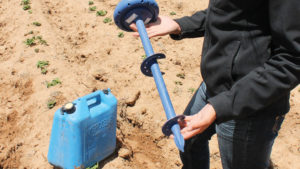
Kerr uses measures soil moisture both manually and with instruments.
2. Sharper staff focus on water. Even in fields without sensors, NAPI is watching moisture profiles more closely. It wants to ensure it has water banked in the ground as a buffer against any future emergencies.
“We have a department with field scouts that devote about 100% of their time to water management,” Castro says.
Scouts regularly dig to the bottom of the root zone, from 12 to 20 inches, depending on the crop’s maturity, and adjusting irrigation to match what they find.
“I think they’ve become better water managers as a result. Our crops are looking exceptionally good this year, and I think it’s due to being better water managers,” Castro says.
3. Guarding the pipeline: The pipeline has proven itself as vital to NAPI’s survival, and it’s in need of extensive repairs that were neglected in the past. The government originally allocated $11 million per year to maintain the system, but over time has cut that back to $4 million.
Castro says replacing the entire system would be cost prohibitive for NAPI. To catch up with all the deferred maintenance, it would cost an estimated $174 million, based on a study conducted two years ago.
Taking care of that level of repairs or replacement will involve Congress.
“And it just doesn’t happen that fast,” Castro says.
“Things are just piling up, so we cover the essential things out of our own pocket here,” he continues. “As a company, even though that part of the business falls under the Navajo Indian Irrigation Project — that supposedly gets funded by Congress — we’re constantly having to participate directly so we don’t have any issues.”
As a result, NAPI now keeps a stockpile of extra parts for the pipeline on hand. It has installed cameras throughout the system. In this past off-season, it emptied the conduits and used cameras to check the integrity.
“We’re going to be doing some protective coating in there in the off-season next year. We’re going to have to be investing money in there every year,” Castro says.
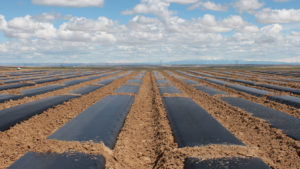
This year, NAPI is testing plasticulture and drip lines, weighing how extensively the methods will be used across the operation in the future.
4. Plasticulture. This year, NAPI is growing a full third of its vegetable crop with plasticulture. It’s the first time doing so, which means it’s also the first time it’s used drip irrigation on a large scale.
5. Crop diversification. Castro was brought on board to help diversify the crops grown at NAPI. Already he’s added natural fits like cantaloupe, small watermelons, winter squash, onions, and garlic. And it’s testing crops it would like to grow next year: tomatoes, bell peppers, and cucumbers.
6. Organic growing. This year, NAPI dedicated about 1,000 acres to organic produce. Switching to organic production not only helps give the operation more financial stability through higher margins, it has found a sweet spot in the U.S. supply and demand for organic produce.
Due to its climate, NAPI harvests its vegetables in August and September, which follows the harvest season in Arizona and California.
“And we just fit right in,” Castro says.
This year, there are 600 acres of red, yellow, and russet certified organic potatoes, a 100 acres of organic onions and organic garlic each, and 165 acres of organic cantaloupe, mini watermelons, and winter squash.
By NAPI standards, 1,000 acres is a test area, which Charley says they are using to perfect their methods.
7. Developing relationships with peers. Making big changes like these can be tough on a company, especially its staff. The team has just survived a highly stressful year, and now they are expected to learn new crops and new production methods.
To help them through the transition, Castro took key managers on a field trip.
“When [Castro] first started talking about the diversification project and organics, I think our crop managers were very hesitant about if it would work or not,” Charley says. “But once he exposed them to what happens in California and Arizona, let them take a look at the landscape, they had a very different outlook and were sold that they can do it.”
8. Stronger team spirit. When a company goes through a crisis, a team spirit often emerges. But once it’s over, it’s human nature to return to the status quo.
So far, the NAPI team has continued to operate with close ties.
“I’m seeing that cohesiveness, that relying on one another is still happening,” Charley says. “Barriers were torn down, and I think where we belong as a company is to look for the positive of what happened and build on it.”
That is a great legacy to take into the future.









